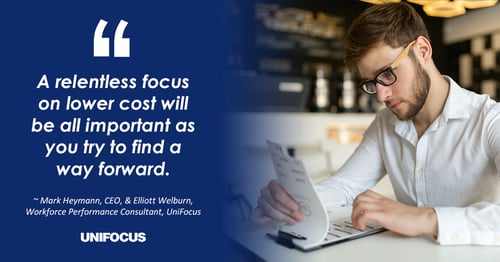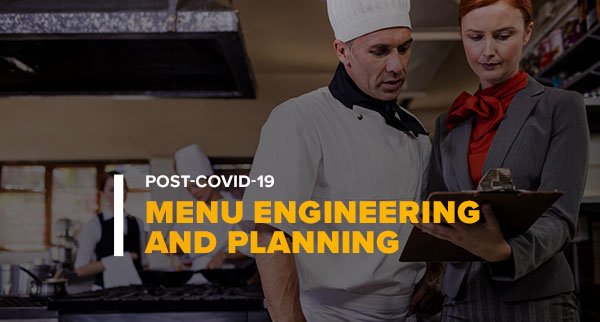#3 in the "Restaurants Post-COVID-19" series. In our previous posts, we have discussed considerations that should be taken into account before re-opening a restaurant and have given a broad overview of what may be coming and how to prepare for this “new” normal. Let’s now turn our attention to one of the key reasons you probably have diners in your restaurant, your food offerings.
Guest satisfaction and food costs, coupled with positioning, are often key factors in menu design. You have probably even kept some items on your menu that did not sell particularly well because you felt they were important to your brand or audience. Some of these items may have added production complexity that at high volumes you were able to justify. This is not a luxury you will be able to afford when you re-open your restaurant.
With fewer diners, every single dish will need to be carefully considered for a myriad of factors including how well the components can be cross-utilized, what the prep time will be, how easily the dish can be picked up (take out), what the “saleability” of the item is, and many others.
 Looking at your sales for July 2019 is not going to provide you with the indicators you need to properly design a post-COVID menu. This will be a multi-step process that should start with pulling your menu mix for several periods of time. As part of the process of understanding your food sales, you need to assess items on a yearly or monthly basis, and evaluate fluctuations in the frequency and types of items sold based upon busy versus slow meal periods and different times of year. These factors are important because unless you are changing your menu on a seasonal basis, you are likely to have some menu items that perform better than others at certain times of the year. The short rib pasta which is a high seller from November to April, might not be a dish you want on your reduced menu in July.
Looking at your sales for July 2019 is not going to provide you with the indicators you need to properly design a post-COVID menu. This will be a multi-step process that should start with pulling your menu mix for several periods of time. As part of the process of understanding your food sales, you need to assess items on a yearly or monthly basis, and evaluate fluctuations in the frequency and types of items sold based upon busy versus slow meal periods and different times of year. These factors are important because unless you are changing your menu on a seasonal basis, you are likely to have some menu items that perform better than others at certain times of the year. The short rib pasta which is a high seller from November to April, might not be a dish you want on your reduced menu in July.
Another factor to be considered is the actual size of your menu. While high levels of variety worked in the past, you will get more out of a streamlined menu that is built for not only success but also speed, than you will a menu that is bloated with the favorites of a small group of regulars or the Chef’s passion project dish. As such, once you have pulled your menu mix and have compared your sales across several meal periods you should develop a list of “rock stars.”
Rock stars are dishes that sell regardless of the time of year or the time of day. They are general crowd-pleasers, have solid contribution margins and frequently do not require much labor. Or, more plainly put, they are the menu item or items that allow you to bring in the more expensive ingredients to experiment with. Essentially, the burger or the steak frites on your menu help pay for the Australian finger limes your chef has been asking for. Obviously moving forward, you will probably not be bringing in finger limes, but you want to lean heavily on the dishes that would normally provide you the financial cushion to do so.
Once you have an understanding of what items you want on your menu, you need to review them for their ability to be cross-utilized. If you are inclined to put Iceberg on your burger, then you should probably serve a wedge salad. If Romaine is more your style, then it makes sense to have a Caesar. Even beyond the type of lettuce, you want to make sure that there is as little waste as possible. If you are bringing in whole chickens, then you need to be making stock. House-made ricotta on a dish? Then you need to find a place for the leftover whey other than the bottom of a drain. Your ability to cross-utilize items on your menu will drive down costs because you will be bringing in less overall product and these lower costs will go a long way in helping you keep your food costs in line. We’re not saying that you can’t have an item of mise en place only show up once on your menu, but if it does it needs to really count. As part of this process you need to assess the raw products you are using and ensure there is not a comparable product at a lower cost.
Additionally, what considerations do you need to give to the cooking and preparation of the items on your new menu? If you are going to bring back your staff at reduced capacity, then you need to be cognizant of the way in which you utilize their hours. Paying four prep cooks for 20 hours of overtime each defeats the purpose of having reduced labor and does not effectively utilize their time. Instead, consider our previous recommendation of staggering the in-times of your prep staff and couple this with a menu that has the right amount of prep on it.
For many items on your menu, there may be cost points where pre-prepped product is less expensive than raw product with the labor cost associated with the same end product. In planning your re-opening, your prep cooks need to execute the lion's share of the work so that your line cooks can focus solely on service. In some cases, the same person may be doing both, but line production time should be kept to a minimum to address speed of table turns.

Depending on your establishment, you may want to consider only running with one staff team. If you were previously not open for breakfast and you maybe broke even for lunch, then you may want to reopen initially only with dinner service. Based on you newly engineered menu, this would allow you to bring your staff in at the applicable starting time ensuring there is enough prep time before opening for service. You could then adjust kitchen staff accordingly or explore whether shift pay works better for this particular model than hourly pay. Typically for a single meal period you can use shift pay to offset potential overtime hours, by pitching it to your staff as a fixed wage they can rely on. One needs to still be concerned with overtime rules, even in this situation.
You also need to think about the kinds of prep your staff will be doing – and then, how this prep can be streamlined for service in such a way that the line cooks producing the food can be set up for success. In many cases this may mean cooking certain items sous vide, or under vacuum. Many of you are no doubt familiar with “sandbagging” a piece of food to reduce the fire time on the pick-up, think of sous vide like the ultimate sandbagging device that also insures your protein or veg will never dry out or overcook. A chicken breast can be held in a vacuum sealed bag, already cooked, just waiting for a line cook to remove it from the bag, sear it in a pan and put it on a plate. All of this can be done ahead of time and will significantly reduce overall fire times. Reduced fire times translate into less time your guests are waiting for food and, in turn, less time they’re spending at the table which as we have noted before will be of the utmost importance when you are trying to operate at reduced capacity.
It is worth noting that serving food cooked using an immersion circulator will probably require a HACCP (Hazard Analysis and Critical Control Points) Plan, and the process of writing one and getting certified can be a long and arduous one. Before you embark on it, you should weigh the associated costs – the circulator, bags, vacuum sealer, and plan itself – against the added time a guest will sit at table waiting for a line cook to take that aforementioned piece of chicken from raw and cook it thoroughly. Then compound that time over hundreds of potential guests and you may find that the upfront costs are recouped in time gained later.
One last aspect of menu engineering worth discussing here is a prix fixe menu. With fewer diners in your restaurant and a greater emphasis on table turns, being able to better tailor and guide your guest’s experience is going to take on an even bigger role than before. A prix fixe menu is a great way to guide your guests. Not only is the timing more built in than a standard meal, which makes it much easier to time your tables, but you will have a more consistent revenue stream because every guest that orders the prix fixe will be paying the exact same amount, which translates to guaranteed dollars. Think of it like Restaurant Week in most major cities across the country. Your guests pay a set price for an appetizer, entrée, and dessert, with some all-important opportunities for upselling in the form of wine, coffee, or an after-dinner drink. The majority of these prix fixe menus utilize preexisting mise en place and can usually be executed at a lower cost to the restaurant. This approach though, will potentially require more menu changes depending on the number of items associated with the prix fixe. Additional variety could help increase guest returns.
A relentless focus on lower cost will be all important as you try to find a way forward. The contribution margin of each item (food cost plus production costs) will be critical. Your dollars will matter more than ever: how you spend them, what you spend them on, and the way in which they are spent. We have spent some time talking about the new normal, and part of that discussion should include a drive to attain and maintain a lower food cost percentage. As everything in your restaurant is linked, a well thought out menu can lead not only to streamlined labor but also to quicker table turns, which could lead to more guests, and in turn more revenue. All things we now need to be more aware of than ever before.
-
Read the other articles in the series:
- #1: Operating Restaurants in a COVID-19 Environment
- #2: Pre-Opening Considerations for Restaurants in a COVID-19 Environment
- #3: Menu Engineering and Planning
- #4: Taking Full Advantage of Available Demand with Post COVID-19 Restricted Restaurant Capacity
- #5: Managing the Back of the House in Post-COVID-19 Re-Opening
- #6: Operating in the New COVID-19 Normal






